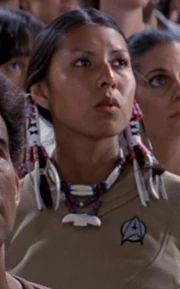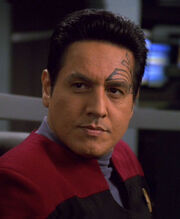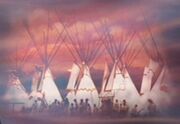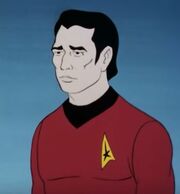No edit summary |
(→American Indian descendants: sentence could do with more commas) |
||
| Line 67: | Line 67: | ||
* [[Volan III Human 004|Volan III inhabitants]] |
* [[Volan III Human 004|Volan III inhabitants]] |
||
| − | {{bginfo|Writer [[Russell Bates]] who created the [[Walking Bear]] character was a native American himself, and came from the Kiowa tribe.}} |
+ | {{bginfo|Writer [[Russell Bates]], who created the [[Walking Bear]] character, was a native American himself, and came from the Kiowa tribe.}} |
== Ships with American Indians names == |
== Ships with American Indians names == |
||
Revision as of 21:53, 16 August 2019

One of the Native American crew aboard the USS Enterprise in the 2270s

Commander Chakotay, the Native American first officer of USS Voyager in 2377

Native American tepees
American Indians (or Native Americans) were the indigenous Human inhabitants of the North and South American continents of Earth. Those areas were heavily colonized by more technologically advanced Humans from other continents after the 15th century, leading to the destruction of many indigenous cultures.
Some Native American cultures experienced a resurgence in the 23rd and 24th centuries. They adapted to their times and circumstances, some tribes included alien species such as the Ferengi, Klingons, and Vulcans as totem spirits. (TNG: "Journey's End")
In the distant past, extraterrestrials known as Sky Spirits came from the Delta Quadrant to Earth, where they genetically altered a group of primitive Humans. These inheritors carried a similar affinity to the land as the Sky Spirits and spread across the globe, giving rise to the Native American and Amazonian peoples. The Sky Spirits returned but eventually found no trace of their inheritors. Descendants of their inheritors who still had the Sky People appearance, the Rubber Tree People, were however still living in hiding on Earth in the Central American rain forest even in the 24th century. (VOY: "Tattoo")
Kukulkan, a benevolent alien being, visited the Mayans and influenced their architecture and agricultural development. Kukulkan was worshiped as a god by the Mayans who encountered him. Kukulkan gave them their remarkably accurate calendar and told them to build a city according to its cycles. On the date the city was finished, Kukulkan was supposed to return. The Mayans built their city, but Kukulkan never appeared, as they had only built parts of the design, they never finished the energy amplification system that was supposed to signal Kukulkan. Kulkukan was remembered in many Native American cultures, including the Aztec, Comanche, and Toltec peoples. (TAS: "How Sharper Than a Serpent's Tooth")
A group of alien anthropologists, called the Preservers, visited Earth several centuries before 2268. The Preservers transplanted a group of Native Americans, including people from the Delaware, Navajo, and Mohican tribes, to a class M planet where they were able to live undisturbed. (TOS: "The Paradise Syndrome")
Scenes of Native American life, including tepees and a canoe, could be seen in the resetting time stream as the timeline realigned itself. (ENT: "Storm Front, Part II")
Davy Crockett was a celebrated "Indian fighter". (DS9: "Once More Unto the Breach")
Native American tribes had traditions about displays of dominance, such as "counting coup," which were noted by Data when observing similar behaviors in the Ligonians. (TNG: "Code of Honor")
By the 2270s, Starfleet permitted Native Americans to express their culture as part of their uniforms. At the time of the V'ger threat, at least three Native Americans were among the crew of the USS Enterprise. (Star Trek: The Motion Picture)
One group of Native Americans left Earth in the mid-22nd century, dissatisfied with changing Terran attitudes towards nature. After two centuries of searching, they created a new colony on Dorvan V, although the system it was in was disputed ground. With the Federation-Cardassian Treaty, the planet was ceded to the Cardassians, and the USS Enterprise-D was sent to relocate the tribe. The tribe however, decided to stay and leave the Federation. (TNG: "Journey's End")
American Indian planets
American Indian tribes and cultures
- Amerind inhabitants
- Aztec
- Chakotay's tribe (unnamed)
- Comanche
- Delaware
- Hopi
- Mayan
- Mohican
- Navajo
- Olmec
- Pueblo
- Rubber Tree People
- Toltec
American Indian descendants
- Named
- Anthwara
- Ce Acatl
- Chakotay
- Joe Falling Hawk
- Goro
- Katowa
- Kolopak
- Lakanta
- Lumo
- Miramanee
- Salish
- Wakasa
- Walking Bear
- Unnamed
- Amerind inhabitants
- Dorvan V inhabitants
- Juhraya inhabitants
- Volan III inhabitants
Ships with American Indians names
- USS Ahwahnee
- Cheyenne-class
- USS Crazy Horse
- USS Lakota
- USS Malinche
- USS Pueblo
- Sacajawea
- USS Sioux
- USS Tecumseh
Other American Indian namesakes
References

Ensign Walking Bear
- TOS: "The Paradise Syndrome"
- TAS: "How Sharper Than a Serpent's Tooth"
- Star Trek: The Motion Picture
- TNG:
- DS9: "Paradise"
- VOY:
